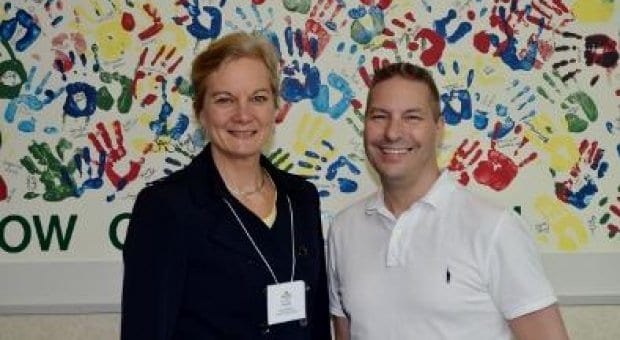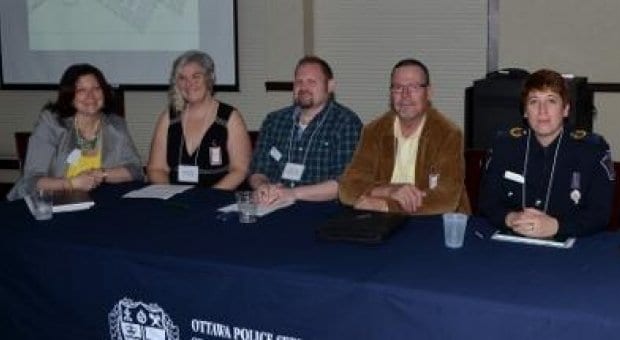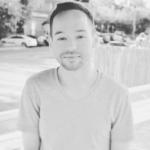
GLBT liaison committee co-chairs Inspector Joan McKenna and Denis Schryburt. Credit: Bradley Turcotte
Police officers, service providers and members of Ottawa’s queer community came together to dissect the realities and impact of hate crimes May 2 at the Ottawa Police Service’s GLBT liaison committee information exchange.
“Hate-motivated crimes are unique, as they can have negative effects on the victim beyond those commonly associated with non-hate crimes,” police Chief Charles Bordeleau said, opening the daylong event.
Not only do hate crimes affect the person targeted differently, but they often affect the person’s whole community, too, Bordeleau adds.
The Ottawa Police Service (OPS) is credited with creating the first full-time hate-crimes unit in the country. It was formed in response to the 1989 murder of Alain Brosseau, a straight man who was robbed and dropped off the Alexandria Bridge because his three teenaged attackers believed he was gay. The trio of attackers then found a wallet in Major’s Hill Park, a popular cruising spot for gay men at the time, and broke into the home of two gay men, stabbing them with knives and screwdrivers.
Sergeant Will Hinterberger joined the hate-crimes unit in 1991 and is the unit’s longest-serving member.
Hinterberger presented a report on hate crimes titled “Then and now” and said that in the 1990s there were many barriers blocking victims of hate crimes from reporting the incidents to police.
Statistics Canada estimates that only two or three hate-crime incidents out of 10 are reported.
In the 1990s, victims feared scorn, ridicule and revictimization, and many had a distrust of police, Hinterberger said, adding that victims of hate crimes in Ottawa’s queer community should no longer fear the police.
“Our organization places a great deal of emphasis and training for our officers on diversity and issues of race relations,” Hinterberger said. “A member of the community needn’t fear coming forward to a member of the police to report he or she was a victim of a hate crime. You will be treated professionally and with respect.”
Hinterberger defines a hate crime as “a criminal offence that is motivated against a person or property which is motivated by hate bias or prejudice based on race, national or ethnic origin, language, religion, sex, age, mental or physical disability, sexual orientation or any other similar factor.”
The most common form of hate crime in Ottawa is graffiti, followed by assault, threats and criminal harassment, which is the least common.
“In order for it to be considered a hate crime, we must first have a criminal offence,” Hinterberger explained.
When a suspect is convicted of a crime, a judge can determine if the motivation is hate, classify the crime as a hate crime and impose a tougher sentence.
Verbal harassment, such as the insults Jer’s Vision founder Jeremy Dias endured from a taxi driver in February, are not hate crimes because, unless the taunting crosses the line into threatening violence, slurs are not against the law.
Gary Leger, community vice-chair of the OPS GLBT liaison committee, investigated Dias’s incident and encourages any member of Ottawa’s queer community who feels they are a victim of hate to contact the liaison committee.
“In this particular case, he was under the impression that it might be [a hate crime]. It wasn’t defined as one. We followed up to make sure that all the steps were taken,” Leger says. “We made sure we gave him proper recourse.”
Staff Sergeant Shaun Brabazon, with the diversity and race relations unit of OPS, says he understands why individuals involved in hate-motivated encounters many be quick to label them hate crimes.
“Anytime someone is subjected to a crime or subjected to mistreatment, it obviously is difficult. But when you have the added complexity of a hate crime, or incident that might be driven by hate, I think it just compounds the matter,” Brabazon says. “A hate crime almost has a deeper cut to it because of the motivation behind it. That’s where this becomes such a personal issue for people.”
Steve Sullivan, executive director of Ottawa Victim Services, says anyone who believes they have been a target of any form of hate should contact his organization.
Hate crimes based on sexual orientation make up 10 percent of all hate crimes, Sullivan says, but hate crimes against gays are more violent on average.
During a panel discussion, George McBeth, of the Ottawa Senior Pride Network, spoke candidly of growing up in the 1950s and ’60s in the Prairies, where violence against gays was the norm.
“I still remember the voice of the first person who called me a faggot, I still remember the first time I got beat up, I still remember the first time I got abused, but I survived,” he says.
McBeth encourages today’s younger generation of queers to report incidents of hate and stand up for themselves.
“If all we ever do is clean the blood off the doorstep, nothing will change,” he says.
The panel also featured Hinterberger; Leger; Alisa McClain, HIV/AIDS educator with the Youth Services Bureau; Donna Watson-Elliott, of the OPS victim crisis unit; and Deanna Schofield, superintendent of operations with Ottawa Paramedic Service.
Attendees of the information exchange were encouraged to ensure a healthy mix of members of the queer community and service providers in their seating arrangement. The tables then engaged in a group exercise, dissecting information from the day and offering recommendations to strengthen the relationship between service providers and the queer community.
Some recommended asking police officers who have gone through diversity training to wear rainbow pins on their uniforms to signal they are allies.
Inspector Joan McKenna, co-chair of the liaison committee, says the OPS will take the recommendations discussed during the group session and compile a report.
McKenna notes that the liaison committee has grown exponentially over the past two decades.
“We’ve learned from the community, and the community has learned how we do our business,” she says. “I always think it’s a journey. Just like hate crimes has been a journey and a progression with legislation and getting that changed.”
Committee co-chair Denis Schryburt says he had a few “a-ha” moments over the course of the day and reiterates Leger’s statement that the liaison committee supports Ottawa’s queer community.
“The big incidents of hate crimes themselves seem to be going down; however, they may not be reported. We really need to get the message out there that if you are a victim of a hate crime, come to the GLBT liaison committee,” Schryburt says. “We can guide you and give you the resources you need.”
A program dedicated to encouraging victims of homophobic violence to come forward, titled Report Homophobic Violence Period, or RHVP: For the Gay, Lesbian, Two-Spirited and Trans Community, will launch in Ottawa in September.


 Why you can trust Xtra
Why you can trust Xtra


